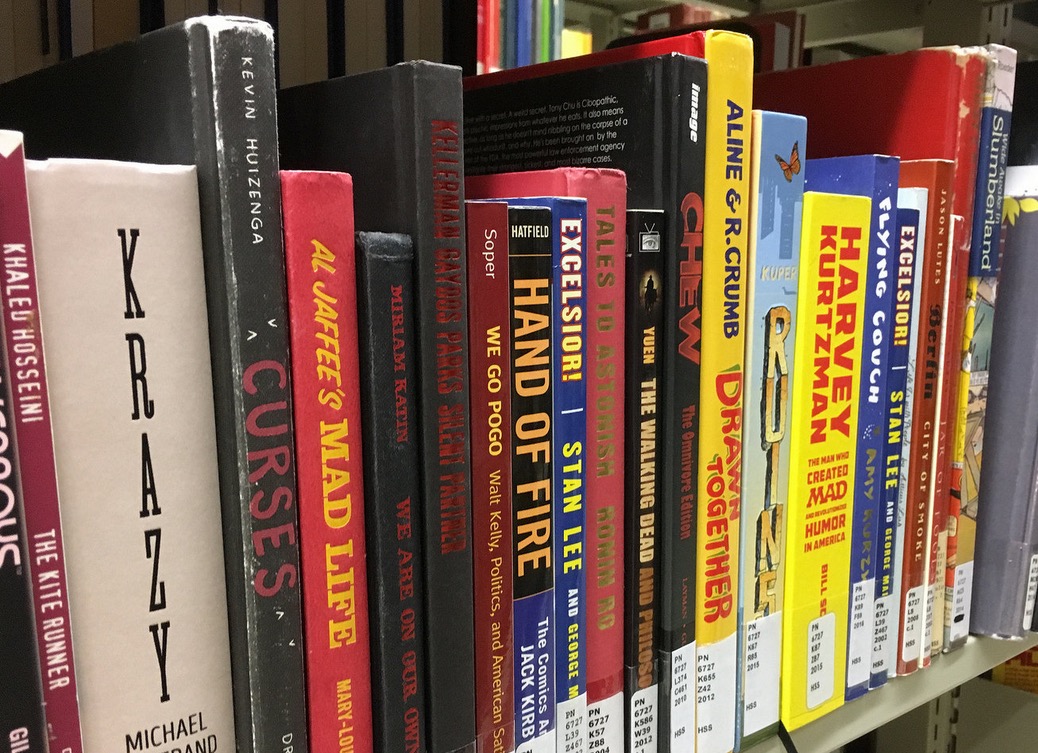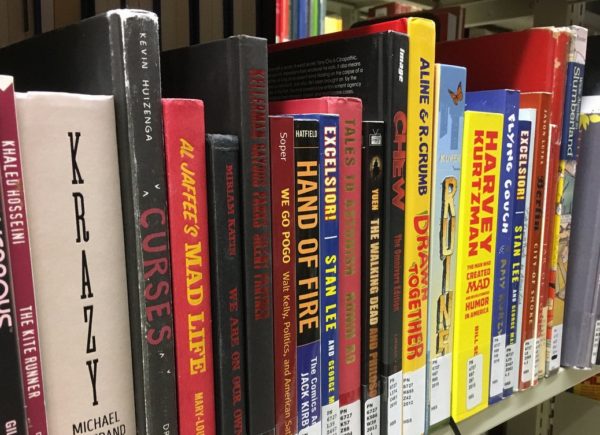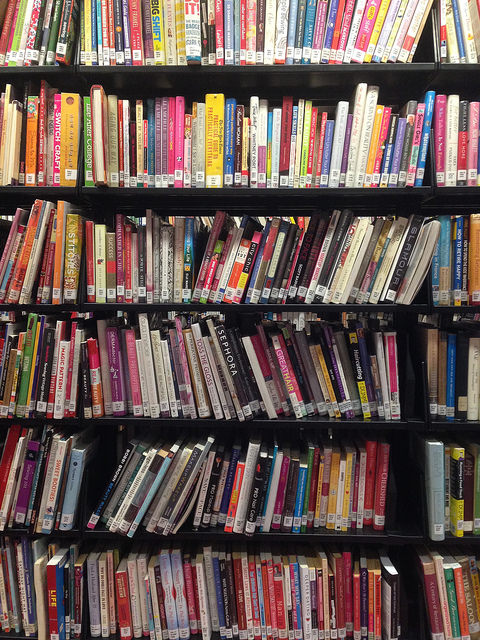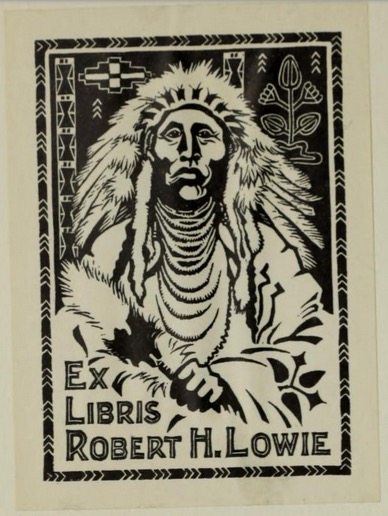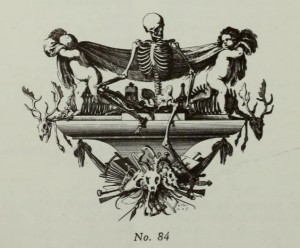I started 106 books this year and finished 102. I seem to have some sort of aggressive attachment to reading serendipitously. Which means no matter what I set out to do, I read whatever the hell I want because I read for fun and can’t really queue up books I want to read. This means it’s hard for me to choose to read more diversely, or read more titles by women. I got some good suggestions from people last year and then watched myself basically ignore them this year. I need to work my actual reading habits in to my aspirational reading life. That said, here’s how the year shook out. It was a good year for reading, but that was also sort of because it wasn’t a great year for me. We muddle forward… Continue reading “2017 reading list and commentary”
Tag: books
2016 reading list and commentary
I started 71 books this year and finished 68. I feel good about not finishing those three. I should really not-finish more books to be honest. I try to read most evenings and most mornings with varying success. I also read a lot on planes and I was not on so many planes this year.
average read per month: 5.67
average read per week: 1.3
number read in worst month: 2 (Jun)
number read in best month: 10 (Oct)
number unfinished: 3
percentage by male authors: 62
percentage by female authors: 38
percentage of authors of color: 7
fiction as percentage of total: 63
non-fiction as percentage of total: 37
percentage of total liked: 87
percentage of total ambivalent: 10
percentage of total disliked: 3
Not as many books this year because I read a few really BIG books (Stephenson and Howey I am looking in your direction) Another year where I read a lot of genre fiction which interferes with reading more by authors of color. A lot of non-neurotypical folks in there, and non-US folks, but that’s not the same. Need to find a way to make this a genuine option for me somehow. Slowly balancing out my male/female reading. I’ve started the Maisie Dobbs series which I like pretty well (though do not love) and read a bunch of “moody seashore” books which were terrific and I’d love to find more. If you’ve made a reading list for last year, I’d love to read it. Happy New Year.
Previous librarian.net summaries: 2015, 2014, 2013, 2012, 2011, 2010, 2009, 2007, 2006, 2005, 2004. My always-updated booklist lives at jessamyn.info/booklist and it has its own RSS feed.
The things I will miss about Open Library
I put it on my newsletter and up on TILT (my online magazine? Whatever that is) but I left my job at Open Library this week. This is bittersweet since I left because I could not get the hours to pay me for all the work that needs doing there. I was paid for ten, looking for (at least) twenty.
Open Library is a bit of a singular beast. They lend ebooks worldwide for free. It’s a grand experiment that’s so far been going pretty well. I like using it because I can search for keywords inside of millions of books and because their reading interface is one of the best there is. I use their public domain books to find illustrations for the talks I give (either on the site or from these five million images on Flickr) and shared out some of my favorites on their Twitter account. So now that I’m not doing that, I can share out some stuff I find here…
Like a neat-looking bookplate, and then doing some research to figure out whose it was. And learning a thing as a result. Here is a bookplate that pointed me towards knowing more about Robert Lowie an early social anthropologist. The book it’s in is actually a book about old books and so has some great illustrations.
I’ll also miss learning more about librarianship as it was once practiced. This Union class-list of the libraries of the Library and Library Assistants’ Associations looks fascinating and yet I’m not even totally sure what it is. Its companion book, the Bibliography of library economy is 400 pages of Reader’s Guide to Periodical Literature type of things only for libraries. I’d almost be reading it for fun but I couldn’t help picking out a few keywords and browsing.
As library topics remain prevalent in the news, everyone likes to thing that being good at Google makes them a proto-librarian. But the longstanding traditions of this institution are more than just finding things. It’s so much more about linking people to the information they want. Every book its reader. Every reader their book. I’m 100% down with digital librarianship being an efficient and effective way to do this, I just need to orient myself to doing that work in more of an actual digital library.
2015 reading list and commentary
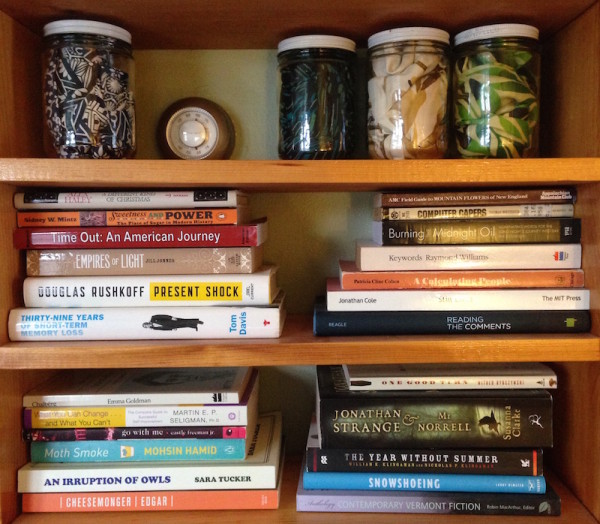
I started 91 books this year and finished 89. I’m now fully in the swing of reading at least 30 minutes before bed which has been great. Last year I had a lot of random low-level health issues which complicated matters a bit but I’m still pretty happy with how the Year in Reading turned out.
average read per month: 7.47
average read per week: 1.7
number read in worst month: 5 (Apr)
number read in best month: 11 (Aug)
number unfinished: 2
percentage by male authors: 59
percentage by female authors: 41
percentage of authors of color: 3
fiction as percentage of total: 73
non-fiction as percentage of total: 27
percentage of total liked: 90
percentage of total ambivalent: 7
percentage of total disliked: 3
The biggest issue this year was that I didn’t actively prioritize reading authors of color and so I just didn’t. No good. Must do better. Did okay with non-US authors but that’s not the same. I did a lot of social justice online reading and kept a bookshelf of worthwhile articles over at This.cm but I needed to translate more of this into book length reading and I did not. Digging into the Louise Penny series upped my percentage of female authors but I still need to work on that. I read a lot of books that I really enjoyed this past year including a history of spam and a photography book about large trees. I got a lot more suggestions from reading Library Journal than usual which was good and bad. I added a few books to my Best in Show shortlist. If you’ve made a reading list for last year, I’d love to read it. Happy New Year.
Previous librarian.net summaries: 2014, 2013, 2012, 2011, 2010, 2009, 2007, 2006, 2005, 2004. My always-updated booklist lives at jessamyn.info/booklist and it has its own RSS feed which is mostly not broken.
2014 reading list, a year end summary
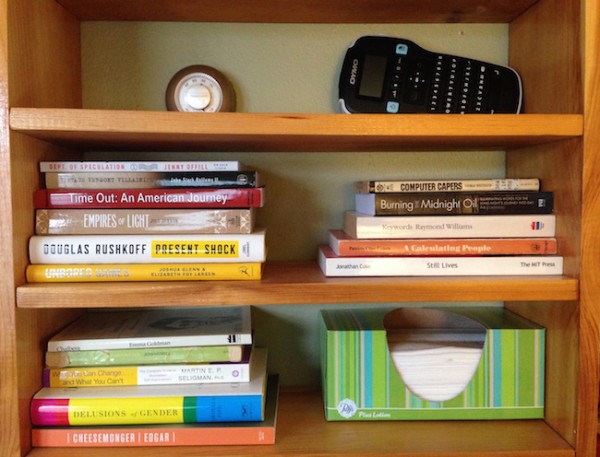
I started 104 books this year and finished 102. This year’s goals were twofold: read more books than last year, and read more diversely. I got the first goal accomplished but sort of at the expense of the second goal. I tried to get into a good daily reading pattern, and dug in to some book series. This meant that when I finished up the books by Archer Mayor, I had just read a large number of books by yet another white guy from New England. I didn’t read as many books by women as I’d wanted. I read a higher percentage of books by non-white, non-Western authors but I still need to do a lot better. I’m really happy to have managed a lifestyle where I read almost every day, off screen, for 30 minutes or more. Now I need to get choosier about what I am reading.
average read per month: 8.67
average read per week: 2
number read in worst month: 7 (Jan/July/Sep)
number read in best month: 11 (May)
number unfinished: 2
percentage by male authors: 79
percentage by female authors: 21
percentage of authors of color: 8
fiction as percentage of total: 70
non-fiction as percentage of total: 30
percentage of total liked: 93
percentage of total ambivalent: 7
percentage of total disliked: 0
A few book-specific notes. I really enjoyed Archer Mayor’s books and am now caught up. I recommend them to anyone looking for a place-based set of cop procedurals. I read almost every book suggested in this Ask MetaFilter thread and I enjoyed most of them. I also read a bunch of YA-ish techie nerdish books like Soon I will be Invincible and Ready Player One which are great books that any people who spend a lot of time online will enjoy. Many of the graphic novels I read were published by First Second and I probably need to read more books by them. I also enjoyed some local New England books both fiction (The Lace Reader) and non-fiction (Bootleggers, Lobstermen & Lumberjacks). One of the things that is odd about reading this many more books than last year is that the books from earlier in the year seem like I read them forever ago and they fade into distant memory. 2014 seemed long in mostly good ways. I also have a few books that I am halfway done with and they have been halfway done for months. I need to find a new way to kick books more quickly to the “unfinished” list. Here’s a chart for this information instead of a long list of numbers. I’m more concerned with trends than specific numbers.
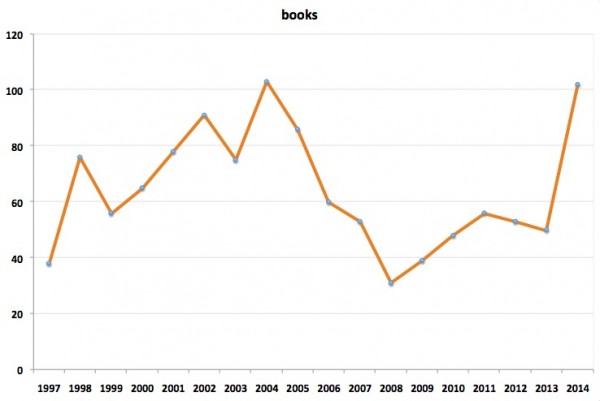
Previous librarian.net summaries: 2013, 2012, 2011, 2010, 2009, 2007, 2006, 2005, 2004. My always-updated booklist lives at jessamyn.info/booklist and it has its own RSS feed which is mostly not broken.
If you’ve made a reading list for last year, I’d love to read it. Happy New Year.
